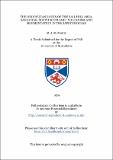The ordovician rocks of the Bail Hill area, Sanquhar, South Scotland : volcanism and sedimentation in the Iapetus Ocean
Abstract
The Ordovician rocks of the Bail Hill area, Sanquhar, South Scotland : volcanism and sedimentation in the lapetus Ocean. by M. J .McMurtry. The Bail Hill area lies in the "Northern Belt" of the Southern Uplands and contains sedimentary and volcanic rocks of Llandeilo/Caradoc age. The sedimentary succession has been divided into four formations - the Glenflosh, Kiln, Spothfore and Guffock Formations. The Glenflosh and Guffock Formations are mainly arenaceous and were largely deposited by turbidity currents flowing to the southwest. They typically consist of Tae units. The fine-grained sandstones and siltstones of the Kiln Formation were also deposited by turbidity currents. Parallel-laminated units in the lower part of the formation represent "overbank" deposits, whilst lenticular- bedded units in the upper part are interpreted as channel- mouth deposits. Bouma sequences are not common in these lithologies. The Spothfore Formation consists of rudites deposited by a variety of sediment and fluid gravity flows close to a feeder system. The petrography of greywackes within the formations shows no significant variation across strike, in contrast to successions studied to the southwest. The provenance of detritus in the sediments is believed to be the north-westerly Laurentian continent with a significant but variable intrabasinal contribution of sedimentary and volcanic debris. A stratigraphic succession for the area is proposed, although graptolite evidence for the relative ages of the formations is equivocal. A new stratigraphic unit, the Bail Hill Volcanic Group, is proposed and the petrography and field relations of the subdivisions within this group are discussed. Field relations suggest that the Bail Hill volcano was a composite, central-type structure. Early basaltic lavas were succeeded by more differentiated lithologies and pyroclastic activity increased with time. The mineral and whole-rock chemistry indicates the Bail Hill Volcanic Group has differentiated along the sodic alkaline series (alkali basalt - hawaiite - mugearite - trachyte). Gabbroic and dioritic xenoliths in the extrusive rocks are believed to be fragments of a large sub-volcanic intrusive mass that underlay the Bail Hill volcano in Ordovician times. The volcanic pile as a whole has undergone metamorphism to zeolite facies grade. Higher grade assemblages in the xenoliths suggest that they were hydrothermally altered prior to incorporation in the extrusive rocks. It is concluded that the Bail Hill Volcanic Group represents the remnants of a seamount within the Iapetus Ocean, whilst the sedimentary rocks record the transition from the abyssal plain into a Lower Palaeozoic trench. Northwesterly subduction of the lapetus Ocean crust resulted in the accretion of the Bail Hill area on to the facing edge of the northwesterly Laurentian continent.
Type
Thesis, PhD Doctor of Philosophy
Collections
Items in the St Andrews Research Repository are protected by copyright, with all rights reserved, unless otherwise indicated.

